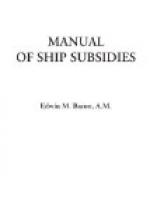5. No goods could
be carried from any one British possession in
Asia, Africa, or America,
to another, nor from one part of such
possession to another
part of the same, in any but British ships.
6. No goods could be imported into any British possession in Asia, Africa, or America in any but British ships, or in ships of the country of which the goods were the produce; provided, also, that such ships brought the goods from that country.
7. No foreign ships
were allowed to trade with any of the British
possessions unless they
had been especially authorized to do so
by an Order in Council.
8. Powers were given to the Queen in Council which enabled her to impose differential duties on the ships of any foreign country which did the same with reference to British ships; and also to place restrictions on importations from any foreign countries which placed restrictions on British importations with such countries.
Finally, in 1849, with the adoption of the commercial policy founded on freedom of trade, came the repeal of the restrictive code, excepting only the rule as to the British coasting trade; and in 1854 the restrictions on that trade were removed, throwing it also open to the participation of all nations.
Meanwhile the British ocean-mail subsidy system for steamship service, instituted with the satisfactory application of steam to ocean navigation, in the late eighteen-thirties, had become established: the first contract for open ocean service, made in 1837, being for the carriage of the Peninsular mails to Spain and Portugal. Although successful ventures in transatlantic steam navigation had begun nearly a score of years earlier, the practicability of the employment of steam in this service was not fully tested to the satisfaction of the British Admiralty till 1838.
In this, as in so many other innovations, Americans led the way. The first steamer to cross the Atlantic was an American-built and American-manned craft. This pioneer was the Savannah, built in New York and bought for service between Savannah and Liverpool. She was a full-rigged sailing-vessel, of 300 tons, with auxiliary steam power furnished by an engine built in New Jersey. Her paddles were removable, so fashioned that they could be folded fan-like when the ship was under sail only.[S] She made the initial voyage, from Savannah to Liverpool, in the Summer of 1819, and accomplished it in twenty-seven days,[T] eighty hours of the time under steam. Afterwards she made a trip to St. Petersburg, partly steaming and partly sailing, with calls at ports along the way. Her gallant performance attracted wide attention, but upon her return to America she finally brought up at New York, where her machinery was removed and sold.




